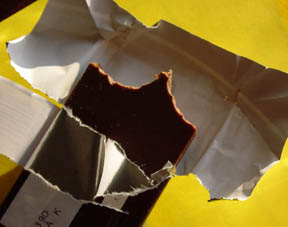Behind the Scenes Chocolate: Mystified - Feb. 21, 2000
By Lisa Strong
Dr. Norman Hollenberg of Harvard Medical School welcomed us and gave us a lively review of the public's growing awareness of healthy eating. In a flash he explained the discovery of the French paradox - the fact that, even though the French have a high fat diet, they have low rates of coronary heart disease. Certain compounds in red wine, called antioxidants, and present in many fruits and vegetables, appear to play a role. Researchers have found that chocolate also contains these antioxidants. Dr. Hollenberg's parting comment about chocolate was, "Don't feel guilty, it might even be good for you." I was primed for more. Next up, "Food of the Gods - Cure For Humanity?" It had a promising beginning. The first known mention of cacao in western culture came in a missive from Hernando Cortez to the Emperor of Spain, dated October 30th, 1520. The talk went downhill from there. What followed was a dry recitation of the purported health effect of cacao found in several surviving documents from 1590 to 1796 and beyond: used to treat fever and liver infirmities; used as a laxative; mixed with pepper, provoked urine; dissipated excessive wind; relieved tiredness; restored flesh. Cure for humanity? More like a cure for insomnia. And then chocolate disappeared entirely. Mars Inc. researcher Harold Schmitz teased out the healthy components of chocolate - procyanidins (a subclass of flavinoids which is a subclass of antioxidant polyphenols, of course) and started manipulating them in test tubes. With no further mention of the familiar, my eyes glazed over, and I slinked out of the session. Who would have thought chocolate could be made unrecognizable. For an interesting look at chocolate, check out The Sweet Lure of Chocolate in the on-line version of Exploring, the Exploratorium's Quarterly magazine.
|
The museum of science, art, and human perception
©2000 The Exploratorium

